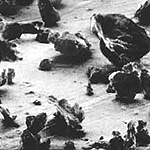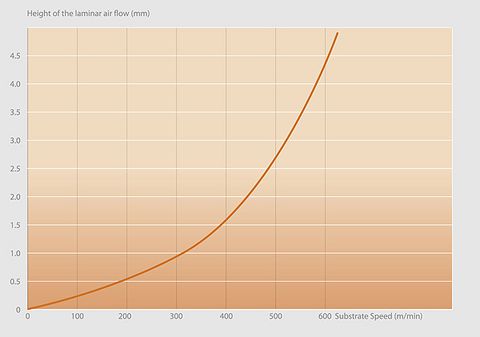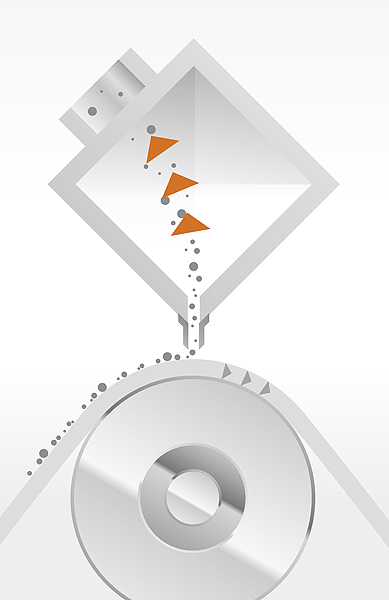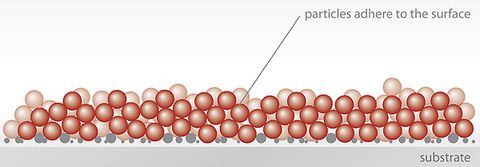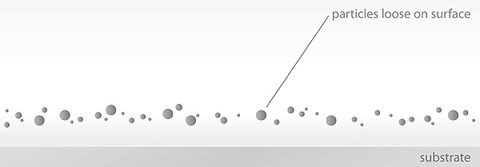The Particle
The particle, which comes in different shapes and sizes, is an unwelcome object, which effects the production process in a negative way. The particle is mainly generated during the substrate manufacturing and slitting. Trapped on the surface, it finds its way into final production where unexpected problems start to occur. In relation to the weight, the particle has a very big surface. This makes it even easier for the particle to become attracted by electrostatic force or to be caught and transported in the boundary layer on the substrate surface.
Loose particle can easily be removed from a still standing substrate surface by a non-contact cleaning system. In order to remove slightly attached particles and fibers an additional force besides vacuum or pressurized air is needed such as still standing or rotating brushes. As soon as we look at particles on the substrate surface, which are effected by electrostatic force or high web speeds, which traps them in the boundary layer, a sophisticated cleaning technology becomes necessary for efficient removal rate results.
The boundary layer
Let's have a close look at the substrate surface at a web speed of 500m/min. The boundary layer grows in thickness exponential to the web speed. Even particles which are slightly above the substrate surface and therefore not in contact with it are caught in this boundary layer and transported through the production process until mechanical contact occurs and the particle is torn out of the boundary layer to abruptly end its journey. This contact can be an idler roll, filter, impression roller or printing plate or stay on the final product. The size of these particles is of immense importance due to the fact, that particles bigger than 30 microns are the once creating most problems and in addition are visible to the naked eye, which is factor when looking at the quality of the final product.
In order to remove these particles from the substrate surface the boundary layer has to be broken and the electrostatic charges have to be neutralized prior to the cleaning process. There are several technologies available today to reach that goal. For all of them it is necessary to remove the particle by using a vacuum and filter system. An air knife may do its job to break the boundary layer, but it also distributes the particles into the nearby environment, where they get caught by the substrate again further down the production line.
Dust removal systems, which are working with a geometrically simple slot in a vacuum tube are very inefficient as soon as higher web speeds are reached. This small vacuum force cannot break the boundary layer. Only an aerodynamic nozzle, which is mounted closely above a backup roll to the substrate surface can generate a forceful enough high velocity airflow to break efficiently the boundary layer even at highest web speeds. At the same time it has to be ensured that this airflow has to have enough volume to remove all particles including the air volume arriving with the substrate due to the boundary layer.
Electrostatic Charge
In many cases electrostatic charge on the substrate is a main factor to increase contamination and additional difficulties for its removal. It is well known, that insulating materials such as paper, film or foil generate static charges by friction. These charges will ensure that particles, which are already on the substrate surface being attached even better to it and additional particles from the nearby environment will be collected.
The smaller the gap between particle and substrate surface, the greater is the force of the electrostatic field holding the particle down. This is why a static control system must be installed prior to the cleaning process to guarantee a neutralized substrate surface and therefore an efficient removal of all particles.
Cleaning Technology
The ultimate goal of the cleaning procedure is to remove all particles prior to the contamination sensitive production process. The requirements can vary between particle sizes of bigger than 50micron for the printing and packaging applications down to particle sizes of less than 2 microns for the film, foil or clean room applications. Unfortunately is it not economical to develop a system that meets all requirements. A label printer will not invest in a non-contact cleaning system, which can clean down to 2 micron in particle size. The return of investment cannot be justified comparing the cost/necessity for this sophisticated technology.
Conclusion
Today's market offers a verity of cleaning systems using different technologies and solution approaches. Each system has advantages and disadvantages. That is why it is necessary to clarify the following points prior to an investment into a surface cleaning / dust removal system:
What particle size has to be removed?
What kind of boundary layer does exist during the process?
Has electrostatic charge a big influence to the application?
Which problem needs to be solved by cleaning the substrate?
What budget does exist?
Following these criteria, the search for a surface cleaning system can begin. The goal is reached when the investment has a short amortization time due to the savings reached by its utilization in the production process and at the same time the cleaning system is efficient enough to solve the problem.
Our Engineers are ready to assist you in finding the best solution.

